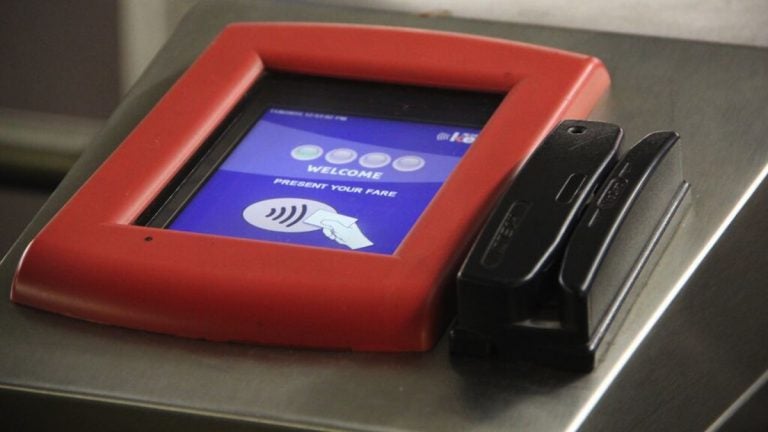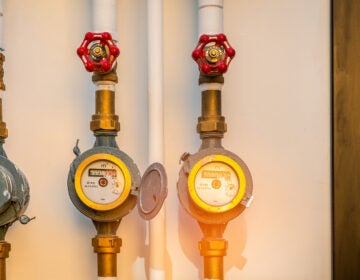FAQs: Electronic fare system SEPTA Key

(Emma Lee/WHYY)
We’ve been hearing about SEPTA’s plan for a new fare system, dubbed SEPTA Key, for some time. Now that the transit agency is getting closer to making electronic fare-payment a reality, here’s a look at what we know so far.
What types of payments will be accepted?
Why did it take Philly so long to get rid of tokens?
Will seniors lose their discount?
What is SEPTA Key?
Key is the name for SEPTA’s new payment technology system, which will replace tokens, paper tickets and daily passes. Riders will be able to use a SEPTA Key card to pay for fares, and those cards will be available at new kiosks being installed across the system. Riders will also be able to use any other payment card or electronic device equipped with Near Field Communication technology, such as tap-and-go credit cards and phones equipped with Apple Pay or Google Wallet.
When will it launch?
Good question. SEPTA originally hoped to launch SEPTA Key in September 2013. That obviously didn’t happened, and SEPTA officials have stopped offering specific rollout estimates. The project manager for SEPTA Key recently said he hopes to begin roll out by April 2016. But SEPTA General Manager Jeff Knueppel cautioned that the software still needs to test for bugs, which means newly discovered problems could push implementation back further.
SEPTA Key will first launch on the agency’s subways, buses, trolleys and high speed line. Regional Rail riders will need a few more months before SEPTA Key replaces the current system of single-trip tickets and monthly passes.
Why is it taking so long?
Basically, there two reasons.
The technology is more complicated than it seems.
Initial estimates were way over optimistic.
Most riders aren’t frustrated because it’s been seven years since SEPTA first announced a Request-for-Proposals for a new payment system.Riders are upset because it’s over two years late. Each delay can be ascribed to specific technological problems or implementation hiccups — including when the SEPTA official running the SEPTA Key project retired in 2014 to join a consulting firm. But, fundamentally, the original estimates were just wildly off.
It’s a problem fairly common in government contracting, where private sector companies make bids for government contracts. Agencies then pick the most competitive bid based on specific criteria, including estimated costs and delivery schedules. That creates an incentive for the bidders to over promise on both time and money in order to win the bid. That problem is made worse when the agency is purchasing goods or a service that it has little experience dealing with, as was the case with SEPTA Key.
What types of payments will be accepted?
In terms of mass transit payment technology, SEPTA is going from worst to first. It’s a major leap requiring a lot of work. While other public transportation agencies have implemented fare card systems for their subways or buses, SEPTA’s will be the first to be used on five different modes — bus, trolley, subway, regional rail and the Norristown High Speed Line — and the first to allow for open source payment, i.e., payment using other NFC-equipped cards and devices. Both information system experts and SEPTA officials have said that either adding additional modes or adding additional payment options alone would increase the complexity of developing this system exponentially. Doing both just makes things that much more difficult.
Why did it take Philly so long to get rid of tokens?
Money and attitude.
SEPTA was at its nadir in both when other public transportation systems started to make the switch to new fare instruments in the late 1990s and early 2000s, such as the MTA’s MetroCard in New York City in 1993.
SEPTA also had more pressing needs than replacing an antiquated, yet still functional, payment system: the Market Frankford El was at risk of collapsing, old dirty diesel belching buses needed to be replaced, the old electrical system kept shorting out and much, much more.
And SEPTA officials will admit that, for many years, the agency largely ignored customer concerns. SEPTA administrators used to talk about managing the system’s decline, not improving or expanding services, or improving the customer’s experience. Under current SEPTA Board Chair Pat Deon and recently-departed GM Joe Casey, that changed. Casey created a Customer Relations Division and the transportation authority began to focus for the first time on improving customer experience.. Improving the fare system is arguably the largest and most dramatic example of that attitude shift.
Will seniors lose their discount?
No. Seniors and all others who enjoy discounted and free rides on SEPTA have nothing to worry about. Already, seniors can use their Pennsylvania ID cards to swipe onto subways, trolleys and buses using the SEPTA Key fare equipment. As SEPTA Key launches, they will have the option to get a special SEPTA Key Card for seniors, which will automatically apply the senior discount.
WHYY is your source for fact-based, in-depth journalism and information. As a nonprofit organization, we rely on financial support from readers like you. Please give today.




